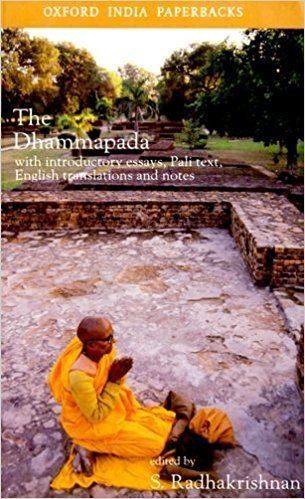Language English Pages 194 Originally published 1950 Page count 194 OCLC 36531930 | ISBN 0-19-564080-2 | |
 | ||
Publication date 1950; 1954; 1958; 1966; 1968; 1980; 1982; 1984; 1988; 1991; 1992; 1997; 2007 Sarvepalli Radhakrishnan books Eastern religions and west, Religion and Society, An idealist view of life, The Hindu view of life, philosophy of Rabindra | ||
The Dhammapada: With introductory essays, Pali text, English translation and notes is a 1950 book written by philosopher and (later) President of India, Dr. Sarvepalli Radhakrishnan (1888–1975), about the Dhammapada, an important Buddhist scripture. Originally published in 1950 by Oxford University Press, the book has been republished numerous times by the same publisher, most recently in 1997. A 2007 Indian edition was published by Pilgrims Publishing. The book has been reviewed in several professional journals. All editions have had 194 pages and have used the same title.
Contents
Outline of book
Radhakrishnan's Dhammapada contains original Pali text as well as English translations of the Dhammapada's 26 chapters. It begins with a preface composed in 1950 in which Radhakrishnan states that
To-day... We have come to recognize that it is either one world or none. The effort to build one world requires a closer understanding among the peoples of the world and their cultures. This translation of the Dhammapada... is offered as a small contribution to world understanding. The central thesis of the book, that human conduct, righteous behaviour, reflection, and meditation are more important than vain speculations about the transcendent - has an appeal to the modern mind.... Books so rich in significance... require to be understood by each generation in relation to its own problems.
The preface also states that
[The Dhammapada's] teaching - to repress the instincts entirely is to generate neuroses; to give them full rein is also to end up in neuroses - is supported by modern psychology.
Next is a 57-page introduction that is divided into two main sections. The first introductory section, less than 3 pages in length, is entitled simply "The Dhammapada," and briefly summarizes the Dhammapada's historical context, noting that its verses connect with incidents in the Buddha's life "and illustrate the method of teaching adopted by him." The second section, entitled "Gautama the Buddha," has several subsections:
Also in the fifth section, Radhakrishnan offers his interpretation of three "inadequacies" or "exaggerations" in the Buddha's thought, which "revealed themselves in [Buddhism's] later history and relation to Hinduism." These are that i) "Philosophy is a natural necessity of the human mind," and the Buddha's hearers were unable to adopt suspended judgement on the ultimate questions; ii) "The Buddha's conception of dharma as the absolute reality was not sufficiently concrete for practical purposes"; and iii) The Buddha taught that one could renounce householder duties at any age. Radhakrishnan states that these "exaggerations" are understandable if we realize that in the Buddha's time, attempts to lead the spiritual life had to contend with "three great enemies... the theologians, the ritualists, and the worldlings."
The largest part of the book (pp. 58–187) consists of a romanized transliteration of the original Pali text, plus a verse-by-verse English translation. Two examples are shown in the table at right. Many verses are augmented with footnotes or are followed by commentary, presented in a smaller font size than the verses themselves. The book concludes with a short selected bibliography, a 4-page Pali index (indicating which verses contain a specified word), and a 2-page general index.
Reception
The book has been reviewed in professional journals that include The Journal of Religion, Philosophy, Bulletin of the School of Oriental and African Studies, and Journal of the Royal Asiatic Society of Great Britain and Ireland.
Ashby stated that "the distinct contribution of this volume is the Introduction," where "Radhakrishnan sets out in clear and penetrating fashion to give the reader a basic understanding of the thought-world in which Buddhist ethical teaching moves. His discussion of the relation of the teachings of the Buddha to the Upanishads and his examination of the metaphysical views of Sakyamuni will prove valuable ... [and his] insistence upon the positive nature of the Buddhist conception of Nirvana is recommended reading for... victims of the 'annihilation-extinction' theory of Nirvana."
Horner noted that the same Pali word is translated differently by Radhakrishnan in different places. "Pali technical terms are, of course, recognized to contain a subtle variety of meanings. Some of these will be appreciated by anyone making... the reasonably intensive study of this volume which it deserves as well as makes possible." For example, "Professor Radhakrishnan translates dhamma in the text by 'virtue' and by 'law.... Thus, asava is rendered by 'passions', 'taints', 'impurities', and... Samadhi is usually 'tranquillity', once (ver. 271) 'meditative calm'."
Brough described the book as "a convenient presentation of the Pali text, and... a useful introduction to the work for beginners in Pali," although "a comprehensive textual study in the light of the Tibetan and Central Asian parallel verses is still awaited."
In the journal Philosophy, Stede stated that "On the whole, the translation is clear and accurate." She added that the translated verses are "frequently... supplemented by explanations taken from the early commentator Buddhaghosa and by comparative passages selected from philosophical and theological texts of East and West. Although perhaps too numerous, these extraneous references give evidence of the translator's wide learning."
Editions
Editions have been published in 1950, 1954, 1958, 1966, 1968, 1980, 1982, 1984, 1988, 1991, 1992, 1996, 1997, and 2007, and include:
